
Fort Gibson’s rich history includes maintaining peace in turbulat times
In 1824, the federal government needed a new site for military presence because Fort Smith in Arkansas was too far away to adequately fulfill a mission.
The mission was to protect the nation’s southwestern border, facilitate moving Eastern tribes to their new land in what is now Oklahoma and to maintain peace between the Cherokee and Osage tribes who were disputing prime hunting grounds. The new military site was heavily forested and hilly, as well as near the Grand, Arkansas and Verdigris rivers. The rivers provided important transportation access for goods and services but most importantly proximity to mission objectives, advantages put to good use for many years in connecting outlying regions including Texas and the no man’s land of the Panhandle.
The land selected for the exact site was low and marshy, but because it was previously occupied and somewhat cleared, using that site seemed to make sense. Serving first as an open garrison or military camp, the site proved difficult. The low grounds experienced periodic flooding that fostered malaria and pneumonia, in addition to hindering gardening which decreased soldier health. Lack of fresh fruits and vegetables brought about scurvy and dysentery though using cider vinegar as a stopgap measure to increase vitamin C levels helped.
A result of the flooding is that Fort Gibson, named in honor of the nation’s first Commissary General of Subsistence, prompted a move to a nearby hilltop with the only remains of the original site being some foundation walls. Col. Matthew Arbuckle was the fort’s first commander and served for almost 20 years. He was an extremely effective peacemaker in spite of the influx of 40,000 unhappy Eastern tribes.
Because Fort Gibson so successfully maintained peace through the Indian Removal, Mexican-American, Civil and Indian wars, it never gained the reputation of other more conflict-ridden forts. In fact, the fort maintained good relations with people sharing medical treatment and even food when needed. Fort Gibson’s history is rich and well deserving of becoming a WPA project in 1936, which included a reconstruction of the original stockade and some of the other buildings. In 1960, the site was designated as a national historic site with a museum added in 1971 with the purpose to interpret the fort’s history and importance. Then, in 1983, management of the site changed and Fort Gibson Historical Site became part of the newly established Fort Gibson Military Park.
The heart of the museum at the top of the hill is the reconstructed commissary with various displays, most from the 1830s and 1840s. The displays include a camp scene, the Civil War, music and weapons, including the innovative Halls Rifle, the Confederacy and a 15-minute film. The commissary also includes an interactive room for children and big “kids” to try on clothing including shoes with wooden pegs. A cabin with military and civic artifacts is another favorite attraction with the reconstructed stockade usually being the first thing visitors see in the park. Later this year or early next year, an 1870s hospital, currently being rebuilt, will be open to the public.
Individual tours are not available, prearranged group tours are with groups as small as eight. Group tours are usually hosted by Omar Reed, museum director, during which he poses as a historical figure in period dress while explaining what visitors are seeing in a process called living history. Among his “characters” are a mountain man, a Civil War figure, a member of the 25th infantry and Bass Reeves; who was the first Afro-American United States Marshall west of the Mississippi.
“For me, this is not a job but an adventure,” Omar commented. “I learned something new every day and I get to portray these historical figures which captures people’s attention and makes the history come alive.”
The Fort Gibson museum also boasts a number of annual events much appreciated by the public. On the last Saturday in March and the second Saturday in November, the museum hosts spring and fall baking days with breads baked in the site’s brick oven.
A popular annual event is Spook in the Fort, hosted through a cooperative effort of the museum, the Fort Gibson Chamber of Commerce and the local police department. While the police work hardest on decorations including a motion sensitive dummy with glowing eyes and dry ice to spread eerie fogginess so necessary during Halloween, the Chamber hands out candy while the museum offers spooky stories about the spirits of the fort which may include spurned lover Vivia who chased her unfaithful military lover to the fort with dire results,
Easter is not forgotten. With the help of churches, an Easter egg hunt celebrates the season along with a fire truck and police cruisers for the children to see and touch.
“This is a good quality museum with old buildings and information that allows the public up close and personal view of the breadth and diversity of history,” Omar said.







